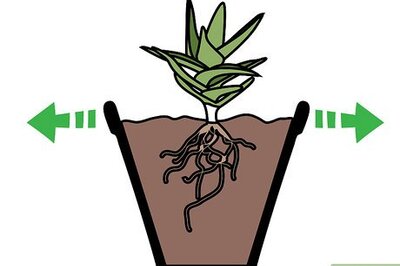
views
The national capital and NCR region is heading towards ?that time of the year?. Pollution is rising, along with people?s attention towards the air quality index (AQI). But despite the exponential increase in air pollutants over the winter months ? driven by a range of factors including unfavourable environmental conditions and stubble burning ? the issue is a perennial one, and not limited to just Delhi in winters.
It is an issue all-year round, affecting India?s population all the time, in dangerous ways that are lost in the jargon that accompanies discourse around air pollution. Continuous exposure to pollutants SHORTENS our lives by YEARS, increases health problems, including in youngsters, and is also the cause behind some terminal illnesses ? such as cancer. However, there is a lack of enough political mention of the issue even ahead of elections in India, and it also fails to come up in people?s top ?governance issues?.
ALSO READ | Delhi Anti-dust Campaign: 103 Sites Inspected So Far, 32 Cases of Violations Recorded
Need ?Saans? Along With ?Bijli, Paani, Sadak? Poll Campaign
According to a survey on governance issues conducted by the Association for Democratic Reforms ahead of the 2019 elections, ?Paani? and ?sadak? problems (water and roads) ranked third and fourth, respectively, and bijli (domestic power) ranked 12th. The survey included around 273,000 participants from 534 constituencies in 32 states and union territories.
Air pollution ranked 17th, with just 11.95 percent of respondents (both urban and rural) naming it when asked which issues they believe are most important for the government to address. According to the survey, water and air pollution were not among the top 25 issues of rural voters. Meanwhile, the problem was the sixth most important to urban voters, with slightly more than 34% of all respondents naming it.
Water and air pollution were among the top three priorities in cities like Delhi and Chandigarh, but not in states like Haryana and Uttar Pradesh ? which also suffer from record air pollution levels. The survey discovered that Telangana was the only state outside of the Indo-Gangetic Plain (IGP) where water and air pollution were in the top three issues, but only in metropolitan areas. The data, while unable to reflect on the political landscape post-2019 is indicative that air pollution is not in voters? minds as much as it should be.
Poll Manifestos Not Enough
Air pollution did make its way into the poll manifestoes of the Congress, and the Bharatiya Janata Party ahead of the 2019 general elections, however, experts said the mention was not all it was meted out to be, as some promises failed to take an on-ground approach, and some lacked ambitiousness.
Arvind Kejriwal?s seven-step anti-smog action plan, and other measures announced to reduce pollution, seem an ?encouraging step? and ?breakthrough? in air pollution politics ahead of his re-election campaign, as argued in an ORF report, the measures are more reactive in nature.
Assembly elections are approaching in some states, including Punjab, where stubble burning not only affects Delhi, but the state?s own statistics do not reflect positively on the issue. According to the Down to Earth and Centre for Science and Environment?s annual study titled ?State of India?s Environment 2021,? Punjab reported 41,090 deaths attributed to air pollution in 2019, accounting for 18.8 percent of overall fatalities.
Members of an anti-pollution NGO ?Clean Air Punjab? have also recently asked all political parties to include time-bound measures to address air pollution and public health issues prominently in their manifestos.
?Tyranny of Proximity? and Accountability
Former Lok Sabha member Kalikesh Deo, and Anant Sudarshan in an article in 2019 argued that ?the challenge with air pollution is that although everyone is hurt by it, it is regarded as nobody’s fault, making it rarely an important factor motivating voters.?
They say that as a result of pollution not being viewed as a political promise in India, courts, rather than elected officials, have driven a disproportionate number of policy decisions, ranging from ordering companies to close to requiring major transformations in the fuels used for public transportation. This is unsustainable, they argue, because, ?only executive and legislative efforts can produce long-term solutions.?
According to a report in Firstpost, ?the tyranny of proximity? is also behind voters in India not caring enough about air pollution issues. It explains that people care about issues that are either imminent or have been bothering them for a long time. Delhi?s pollution problem fails on both counts: it is neither immediate (pollution decreased in early January) nor persistent over time (the problem arises for 3 months annually, and then disappears). The report also argues that the effects of pollution are rarely seen in real time, giving another reason for politicians to be ?mute on the subject?.
Scientific jargon and not enough emotional emulation of the issue also drives people?s apathy into demanding accountability from its leaders on air pollution. Vital Strategies, a global health advocacy firm, analysed news and social media posts over a three-year period till 2018. Its report titled ?Hazy Perceptions? revealed a lack of public understanding of the key causes and treatments for air pollution.
Over a three-year period, the Vital Strategies study investigated 500,000 news and social media posts in 11 South and Southeast Asian nations to assess public understanding of the causes and solutions to air pollution. They found out that the general public has a poor knowledge of the long-term health repercussions of poor air quality. Short-term health effects, such as coughing or itchy eyes, are significantly more frequently mentioned in news and social media articles than long-term health risks, such as cancer. The public debate does not focus on the primary causes of air pollution. The most significant polluters, such as domestic fuels, power plants, and garbage burning, are given less attention by the public than sources such as automotive emissions, it also said.
The majority of public debates focus on short-term solutions. Conversations about short-term personal protection, such as wearing face masks, are far more popular than those concerning long-term solutions, such as trash burning prohibitions, the report argued. Seasonal fluctuations in air quality are driving the discussion, the report said, adding that air pollution is most frequently mentioned from September to December, when air quality is exacerbated by the winter season and farmers? crop burning methods. This makes it difficult to persuade the public to support efficient air pollution control, which necessitates year-round, ongoing efforts, it said.
Viewing Pollution as a Social Issue
One of the ways to bring pollution into political discourse, is to acknowledge that it also stems from social decisions. It is not just a wayward environmental issue but also a social one, influenced by ideologies and decisions. This point is more denounced in the United States, where the issue of climate change becomes a partisan one, with Republicans more or less have banked against the issue, and Democrats have included environmental rhetoric as one of their poll planks and promises.
Environmental issues ? including pollution ? also disproportionately affects vulnerable communities around the world, reports show. This would arguably make it a rights-based issue as well.
“Pollution is a growing public health crisis that directly interferes with human rights,” Edgar Gutierrez (Minister of Environment and Energy of Costa Rica) and President of the UN Environment 2017 Assembly has said. Gutierrez said while effective pollution-control measures should have beneficial economic, environmental, consequences, their ultimate goal must always be to increase human well-being.
Indoor Air Pollution as a Rights-based Issue
A 2013 study in the Health and Human Rights Journal argued that household indoor air pollution from open-fire cookstoves is a public health and environmental hazard which impacts negatively on people’s right to health.
One of the Prime Minister?s projects, the Ujjwala Yojana was pushed hard by the BJP ahead of 2019 polls. It distributes free cooking gas connections. Air pollution in the kitchens of up to 80 million homes was critical, even though the general issue of air quality was not a key theme. Indeed, two government initiatives, the Ujjwala Yojana for cooking gas and Rural Electrification, are critical to lowering air pollution and accompanying mortality, as argued in this ORF report. Bringing air pollution, and its health benefits into the gambit of political discourse and accountability would also pave way for the acknowledgement for such schemes into bettering lives. In fact, a 2018 ICMR study said the scheme helped decrease air pollution.
Read all the Latest News , Breaking News and IPL 2022 Live Updates here.



















Comments
0 comment